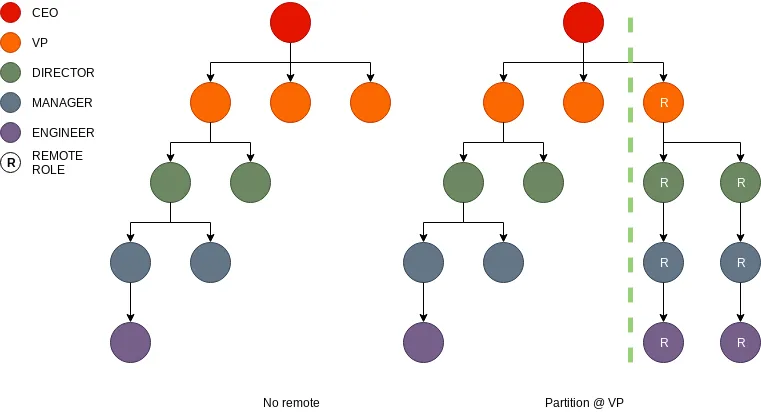Say you own a large company of several thousand employees and wish to extend it across the ocean in a different geography. How would you go about it?
Partition by discipline. You could keep the Marketing discipline in different continent (or engineering for that matter). Decision making may become hard, and a lack of complete visibility may make things worse.
A slightly better model can be Partition by Charter. You institute a brand new business and handover the helms to a trusted VP. This can thrive well if the business aligns with the geographic region (e.g. digital payments in developing countries). Cross discipline work remains intact with all disciplines available locally.

Cross organization collaboration may be difficult. It’s a geo tax that you’d pay anyways to expand the company. This division by charter also appears quite natural. We see it in our social/political fabrics, e.g. in governments, hospitals, schools etc..
Key question: how do you get a VP onboard to start the new center? Do you have someone trusted who understands the business well and is willing to move over across the ocean? Rarely the answer is yes.
Partition by X. You start a small 10 member team in the new geography. Let the EM report onto one of your Directors. The business priorities (and hence the product backlog) remains shared across the primary org and the satellite across ocean. Organically based on depth of expertise you start increasing the charter in satellite.
As the satellite grows, two kinds of reporting chains emerge. A solid line
implying direct report and a dotted line implying business/product reporting.
E.g. if a EM has a dotted line to a Director, the Director owns the
business/product; the EM is a contributor. A solid line reporting is optimized
for functioning of the org (not necessarily business). The Director in solid
line is accountable for people and operational aspects.

As you can imagine, the new organization started with one or two EMs, slowly grows into Directors and eventually has a VP onboard at the remote location. It mitigates the usual risks associated with a remote organization by starting small and evolving organically. Directors at remote location start reporting into VPs across the ocean and so on.
Note from the top-down the difference between a Director and an EM is quantity of products the team contributes into. Call it side-effect or a natural consequence, this model appears to reward breadth. A successful EM can manage a diverse portfolio of multiple product areas (quantitatively multiple Directors). Showing such potential, the EM gets rewarded with promotion into a Director. Keeping elephant aside, you will notice that there is always a desire in a remote center to evolve the dotted structure to one which more vertically aligned. From our perspective, we are not religious and are going to learn the strengths.
We have arrived an interesting juncture. The incentive for an EM or a Director at the primary location appears to be expertise or depth. You own a product, make it the best; own the business, increase the revenue. Do this and grow. Compare the EM or Director at the primary location versus at the remote. You own parts of products (= diverse portfolio), you grow.
Now if you’re looking for a product decision, whom would you bet on? Who would have more customer empathy? Who would have superior technical depth? Easy one. Bet on the depth individual, the primary.
There are some mitigations to the gap here. A Director or VP at the remote location can pick one or two key problems from her portfolio. She could organically grow it. That can make her an expert and add to the desire of vertical ownership (our first model). Anyways if expertise were embedded into the rewarding mechanics at a remote location, life would have been super awesome.
Remember we were talking about choosing a team in the last post. Organization structures are an environment aspect in the choices you make. It has several implications.
If you’re a manager, the goal is straightforward. Be aware of the strengths of your solid line and dotted line. Be one with the dotted line for all business decisions and try to be looped in as much. Solid line relationship can help you with generic advice around picking the right projects, evaluation and trimming the investments etc.. Only exception is if you work on the one or two key problems that your solid line Director is also working on. You can leverage reporting structure in this scenario.
If you’re a engineer (or a leaf node, as I call myself :)) decisions are slightly nuanced based on your goals. If you’re in a junior role, pick any team. Choose one which provides you the opportunity of a good computer science problem. Your growth is a function of technical decisions you can take! So learn a stack, understand the decision parameters and solve some awesome challenges.
Say you’re in senior engineer role and want to work on technical skills. Choose based on two criteria: (a) an org/team where there are enough senior people to throw around ideas/whiteboard and work in a community, (b) try to align with the key one or two problems either in dotted or solid reporting lines. Remember narrow and homogenous builds depth.
On the other hand, if you want to grow non-technical skills, choose a solid line where you have more freedom. Embrace broad and heterogenous. Stay out of the critical execution boundaries. You control the fate of your part of the pie; you need to mop the floor at times and live with the fact that you have to hustle a lot. This involves words like impact, influence and so on which I don’t fully understand. I will shut up.
Thanks for reading so far.